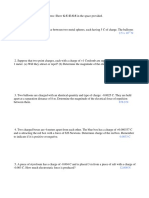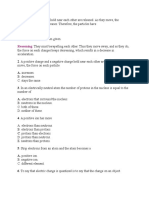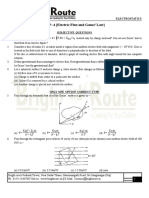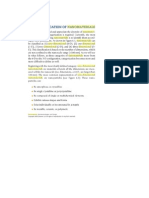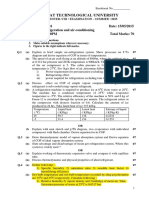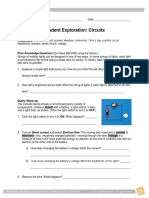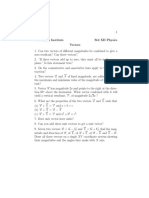Lecture Notes On Electric Field
Lecture Notes On Electric Field
Uploaded by
Renjith Raveendran PillaiCopyright:
Available Formats
Lecture Notes On Electric Field
Lecture Notes On Electric Field
Uploaded by
Renjith Raveendran PillaiOriginal Description:
Original Title
Copyright
Available Formats
Share this document
Did you find this document useful?
Is this content inappropriate?
Copyright:
Available Formats
Lecture Notes On Electric Field
Lecture Notes On Electric Field
Uploaded by
Renjith Raveendran PillaiCopyright:
Available Formats
Electric field Electric field due to a charge is the space around the charge, in which any other charge
is acted upon by an electrostatic force. Electric field intensity The electric field intensity at a point due to a source charge may be defined as the force experienced per unit positive test charge placed at that point without disturbing the source charge. The electric field is also known as strength of electric field or simply electric field. Consider that a positive test charge q0 experiences a force , when placed at the observation point (the point, where the electric field is to be determined).Then, electric field at the observation point is given by
........ (1)
The idea of taking is that on placing the test charge at the observation point, the source charge will not be disturbed. The electric field at a point is a vector quantity. SI unit of electric field intensity is newton coulomb-1 (NC-1). Another unit of electric field is volt metre-1 (Vm-1). Force on a charge inside an electric field If is the electric field at a point, then b definition, a charge q placed at that point will experience a force given by
Electric field due to a point charge Consider that a point charge +q is placed at the origin O of the coordinate system. Let p be the point, where electric field due to the point charge +q is to be determined. Let be the position vector of the point P. To find the electric field at point P, place a vanishingly small positive test charge q0 at point P. According to Coulombs law, force on the test charge q 0 due to charge q is given by
Where is unit vector along OP. If is the electric field at point P, then
Or
.......... (1)
The magnitude of electric field at point P is given by .......... (2) From the above expression for electric field, it follows that electric field is spherically symmetric as seen from the charge q and its magnitude decreases inversely as the square of the distance from the charge. Electric Lines of Force Electric field in any space is represented by the electric field lines or lines force. In general an electric field line is a curve drawn in such a way that the tangent to it at each point is in the direction of the net field at that point. The strength of electric field at any point is measured as the number of electric lines of force crossing a unit area held normal to the lines of force at that point. Properties of Electric lines of force 1. Field lines start from positive charges and end at negative charges. If there is single charge, they may start or end at infinity. 2. In a charge-free region, electric field lines can be taken to be continuous curves without any breaks. 3. Two field lines can never cross each other. In case, two lines of force intersect at a point, then at that point, electric field will not have a unique direction. As it is not possible, the lines of force can never intersect each other. 4. The relative closeness of lines of force in different regions of space gives the idea about the relative strengths of the electric field in the different regions. The region, where lines of force are closer, the electric field is strong and the region, where the lines of force are farther apart, the field is weak. 5. Electrostatic field lines do not form any closed loops. This follows from the conservative nature of the electric field. 6. The lines of force never pass through a conductor. This indicates that the electric field inside a conductor is always zero.
Electric field lines of charge configurations. I. Electric field lines due to isolated positive and negative charge.
II.
Electric field lines due to two positive charges
III.
Electric field lines due to two unlike charges of equal magnitude
Electric Dipole An electric dipole is a pair of equal and opposite point charges q and q separated by a distance of 2a.
3
If charges have magnitude q each and the distance from the centre of the negative charge to that of the positive charge is 2a, the product is defined as the electric dipole moment. The electric dipole moment is a vector quantity, is directed along the line joining the two charges from negative charge towards positive charge. It is given by
The SI unit of electric dipole moment is coulomb-meter (Cm). The dimensional formula is [LTA]. The centre of the dipole lies at the midpoint of the line joining the two charges q and +q. The total charge of an electric dipole is zero. Water and hydrogen chloride molecule have electric dipole moments.
You might also like
- Lab Photoelectric Effect PhET Simulation KeyDocument5 pagesLab Photoelectric Effect PhET Simulation KeyAnil KrishnanNo ratings yet
- Chapter 28 Source of MAGNETIC FIELD SVDocument5 pagesChapter 28 Source of MAGNETIC FIELD SVNguyễn Kim ChiNo ratings yet
- (ECE 401) Lecture 1 Introduction To ElectromagneticsDocument26 pages(ECE 401) Lecture 1 Introduction To ElectromagneticsJohnjoseph VeraNo ratings yet
- Capacitor 2 Worksheet BDocument11 pagesCapacitor 2 Worksheet BLiza Macalinao MangalimanNo ratings yet
- Heat & Thermodynamics (Practice Questions PDFDocument41 pagesHeat & Thermodynamics (Practice Questions PDFSaksham100% (2)
- Physics Question BankDocument161 pagesPhysics Question BankNidhiNo ratings yet
- LondonDocument3 pagesLondonRenjith Raveendran PillaiNo ratings yet
- LondonDocument3 pagesLondonRenjith Raveendran PillaiNo ratings yet
- Gabriel Catren - "A Throw of The Quantum Dice Will Never Overturn The Copernican Revolution"Document25 pagesGabriel Catren - "A Throw of The Quantum Dice Will Never Overturn The Copernican Revolution"Evan Garris100% (2)
- Iraqi Specifications Sampling Procedure 2011Document53 pagesIraqi Specifications Sampling Procedure 2011Mohammed Al-Ani88% (16)
- Impact Hammer CalibrationDocument6 pagesImpact Hammer CalibrationRian FauziNo ratings yet
- Electric charGE AND ELECTRIC FIELDDocument20 pagesElectric charGE AND ELECTRIC FIELDsiddhartha2862No ratings yet
- Gauss Theorem - WORKSHEET - 17869718 - 2024 - 03 - 03 - 15 - 46Document7 pagesGauss Theorem - WORKSHEET - 17869718 - 2024 - 03 - 03 - 15 - 46parasbhardwaj52159No ratings yet
- CH6 Electromagnetic InductionDocument45 pagesCH6 Electromagnetic InductionJignesh Bhavsar100% (1)
- Unit - 4 Work SheetDocument6 pagesUnit - 4 Work SheetNathan GetachewNo ratings yet
- Module 2 - RLC CircuitsDocument49 pagesModule 2 - RLC CircuitsPao CastillonNo ratings yet
- Electric Charge and FieldDocument35 pagesElectric Charge and FieldIndraneil SenguptaNo ratings yet
- Home Assignment - 1Document2 pagesHome Assignment - 1chaitanyaNo ratings yet
- Electrostatic FieldsDocument40 pagesElectrostatic FieldscharanNo ratings yet
- Chapter 2 - Electrostatic Potential and CapacitanceDocument29 pagesChapter 2 - Electrostatic Potential and CapacitanceArnab Das100% (1)
- Semistor - VI Physics Paper IV Theory of Relativity-1Document9 pagesSemistor - VI Physics Paper IV Theory of Relativity-1kirki pNo ratings yet
- Coulomb's Law PracticeDocument3 pagesCoulomb's Law PracticeIdris Jeffrey Manguera0% (1)
- Capacitors in Series and in ParallelDocument10 pagesCapacitors in Series and in ParallelGiovanni SlackNo ratings yet
- Coulombs Law - MagnetismDocument5 pagesCoulombs Law - MagnetismYugandhar Veeramachaneni100% (5)
- Capacitors and Its ApplicationsDocument3 pagesCapacitors and Its ApplicationsadeelNo ratings yet
- Electromagnetic Induction - ProblemsDocument3 pagesElectromagnetic Induction - ProblemsHarikrishnan NamboothiriNo ratings yet
- Worksheet ElectrostaticsDocument6 pagesWorksheet ElectrostaticsDEEPA PAPNAINo ratings yet
- Physics Homework #131 Electrostatics Electric Fields: © J. Kovalcin 2000Document10 pagesPhysics Homework #131 Electrostatics Electric Fields: © J. Kovalcin 2000Joshua CooperNo ratings yet
- 11 True/False Questions: Name: ScoreDocument6 pages11 True/False Questions: Name: ScoreAtharv GandhiNo ratings yet
- Chapter 23 - Gauss' LawDocument9 pagesChapter 23 - Gauss' LawVV CepheiNo ratings yet
- Electric PotentialDocument10 pagesElectric PotentialSrishti PathakNo ratings yet
- Theories of LightDocument11 pagesTheories of LightMoa Army100% (1)
- 4 Electric FieldDocument25 pages4 Electric FieldDERRICKKEANNo ratings yet
- Experiment 6 - Ohms Law - Using PhET SimulationDocument3 pagesExperiment 6 - Ohms Law - Using PhET SimulationNano SuyatnoNo ratings yet
- Applications of Semi Empirical Mass FormulaDocument14 pagesApplications of Semi Empirical Mass FormulaaaeyjazpashaNo ratings yet
- Equipotential SurfacesDocument7 pagesEquipotential SurfacesOmar AlThomaliNo ratings yet
- Kirchhoff Law - Problems and Solutions - Solved Problems in Basic PhysicsDocument5 pagesKirchhoff Law - Problems and Solutions - Solved Problems in Basic Physicsbertinalungu33No ratings yet
- 3rd Quarterly Physics 2 STEM Questions and AnswersDocument5 pages3rd Quarterly Physics 2 STEM Questions and Answersronaldo maanoNo ratings yet
- 12 Physics Notes Ch02 Electrostatic Potential and CapacitanceDocument2 pages12 Physics Notes Ch02 Electrostatic Potential and Capacitance8D Audio Tune100% (1)
- ELECTRIC FLUX (Erin)Document16 pagesELECTRIC FLUX (Erin)Mark Francis VillegasNo ratings yet
- Coulomb Law Quiz Review AnswersDocument3 pagesCoulomb Law Quiz Review AnswersLina PinzónNo ratings yet
- DielectricsDocument41 pagesDielectricsSarveshwar Venkatesan100% (1)
- Work Power and EnergyDocument18 pagesWork Power and EnergyTabada NickyNo ratings yet
- Electricity & ElectromagnetismDocument2 pagesElectricity & ElectromagnetismPrasanth100% (1)
- EE QuestionDocument2 pagesEE QuestionLeng A. PradoNo ratings yet
- CIRCUITS 1 - Module 1Document29 pagesCIRCUITS 1 - Module 1Jose EspinoNo ratings yet
- Electrostatics MCQDocument5 pagesElectrostatics MCQMohan Raj100% (1)
- Voltmeter Ammeter MethodDocument12 pagesVoltmeter Ammeter MethodMoh'd M. GharbiehNo ratings yet
- Nuclear Reactions LecDocument32 pagesNuclear Reactions Lecjon alex100% (1)
- DPP-4 (Electric Flux and Gauss' Law)Document8 pagesDPP-4 (Electric Flux and Gauss' Law)Youtuber RSNo ratings yet
- Chapter 19 - Electric Potential Energy and Electric PotentialDocument43 pagesChapter 19 - Electric Potential Energy and Electric Potentialbob rob100% (1)
- 50 TOP PARALLEL CIRCUITS Questions and Answers PDFDocument5 pages50 TOP PARALLEL CIRCUITS Questions and Answers PDFijazNo ratings yet
- Chapter#9 Nature of Light Physics XIDocument13 pagesChapter#9 Nature of Light Physics XISumairaNo ratings yet
- Capacitance and DielectricDocument31 pagesCapacitance and DielectricannyNo ratings yet
- ELECTROMAGNETIC INDUCTION-02-Objective SolvedDocument7 pagesELECTROMAGNETIC INDUCTION-02-Objective SolvedRaju SinghNo ratings yet
- Electricity and MagnetismDocument3 pagesElectricity and Magnetismnaethan.harshaliNo ratings yet
- Single Phase Ac Parallel CircuitDocument24 pagesSingle Phase Ac Parallel CircuitChris Osea AlvarezNo ratings yet
- Coulombs Law, Gauss Law, Electric PotentialDocument50 pagesCoulombs Law, Gauss Law, Electric Potentialbryan valle100% (2)
- Displacement CurrentDocument22 pagesDisplacement Currentkhaleel_anwar2000No ratings yet
- Gauss Law 2 PDFDocument41 pagesGauss Law 2 PDFAbdiyah AmudiNo ratings yet
- XII Physics Chapter 1 - Electric Charges Fields Saju HssliveDocument16 pagesXII Physics Chapter 1 - Electric Charges Fields Saju HssliveKanishk Yadav100% (1)
- Chapter 26 - Electric FieldDocument38 pagesChapter 26 - Electric FieldRachel AustriaNo ratings yet
- Electric Field StrengthDocument13 pagesElectric Field Strengthaidilbackup08No ratings yet
- Applied Physics: Lecture#4 Course Instructor: Engr Kiran RaheelDocument24 pagesApplied Physics: Lecture#4 Course Instructor: Engr Kiran Raheelkhan janNo ratings yet
- Electric Field Summary NotesDocument11 pagesElectric Field Summary NotesVoyce Xavier PehNo ratings yet
- Chapter OneDocument35 pagesChapter Onedavididosa40No ratings yet
- Empty or Full Worksheet PDFDocument1 pageEmpty or Full Worksheet PDFRenjith Raveendran PillaiNo ratings yet
- Hsslive-SAY 224 PhysicsDocument12 pagesHsslive-SAY 224 PhysicsRenjith Raveendran PillaiNo ratings yet
- Hsslive Xi Physics FY 224Document16 pagesHsslive Xi Physics FY 224Renjith Raveendran PillaiNo ratings yet
- Ray and DuelDocument2 pagesRay and DuelRenjith Raveendran PillaiNo ratings yet
- Electrical Quantities (Multiple Choice) QPDocument25 pagesElectrical Quantities (Multiple Choice) QPRenjith Raveendran PillaiNo ratings yet
- Applications Required: AUTODOCK TutorialDocument4 pagesApplications Required: AUTODOCK TutorialRenjith Raveendran PillaiNo ratings yet
- Hse Physics XiiDocument12 pagesHse Physics XiiRenjith Raveendran PillaiNo ratings yet
- 20 Some Properties of Eigenvalues and EigenvectorsDocument9 pages20 Some Properties of Eigenvalues and EigenvectorsAnilSinghNo ratings yet
- Computer Fundamental MCQ Bank PDFDocument30 pagesComputer Fundamental MCQ Bank PDFMuhammad Akram0% (1)
- Theory SC 10Document146 pagesTheory SC 10Renjith Raveendran PillaiNo ratings yet
- Multilayers and Clusters: Condensed Matter Mesoscopic PhysicsDocument2 pagesMultilayers and Clusters: Condensed Matter Mesoscopic PhysicsRenjith Raveendran PillaiNo ratings yet
- Theory of SuperconductivityDocument135 pagesTheory of SuperconductivityRenjith Raveendran PillaiNo ratings yet
- Classification of NanomaterialsDocument25 pagesClassification of NanomaterialsRenjith Raveendran Pillai100% (1)
- Computational ChemistryDocument10 pagesComputational ChemistryRenjith Raveendran Pillai100% (1)
- Physics Question PaperDocument153 pagesPhysics Question PaperRenjith Raveendran Pillai50% (2)
- Current ElectricityDocument14 pagesCurrent ElectricityRenjith Raveendran PillaiNo ratings yet
- Ruy Lopez IntroductionDocument6 pagesRuy Lopez IntroductionRenjith Raveendran Pillai100% (1)
- Biodata Format For MarriageDocument1 pageBiodata Format For MarriageRenjith Raveendran PillaiNo ratings yet
- Introduction To Nano DevicesDocument16 pagesIntroduction To Nano DevicesRenjith Raveendran PillaiNo ratings yet
- Chapter 19 Electric Currents and Circuits - Lecture 7Document32 pagesChapter 19 Electric Currents and Circuits - Lecture 7marcoserasmoNo ratings yet
- Physics II Problems PDFDocument1 pagePhysics II Problems PDFBOSS BOSSNo ratings yet
- 5070 s17 QP 22 PDFDocument20 pages5070 s17 QP 22 PDFMustafa WaqarNo ratings yet
- Rac Gtu PaperDocument2 pagesRac Gtu PaperVirani BharatNo ratings yet
- Worksheet 17Document2 pagesWorksheet 17Vijay BhaskarNo ratings yet
- Paramagnetic MaterialsDocument12 pagesParamagnetic MaterialsawaisaNo ratings yet
- Student Exploration: Circuits: Vocabulary: Ammeter, Circuit, Current, ElectronDocument5 pagesStudent Exploration: Circuits: Vocabulary: Ammeter, Circuit, Current, ElectronAyesha SaifNo ratings yet
- 2020 - A Revisit of Navier-Stokes EquationDocument12 pages2020 - A Revisit of Navier-Stokes EquationAshutosh SharmaNo ratings yet
- Introduction Nuclear-PhysicsDocument7 pagesIntroduction Nuclear-PhysicsMikylla LimNo ratings yet
- Physics 4A Lab 3: Force Table and Vector Analysis: Parts ListDocument5 pagesPhysics 4A Lab 3: Force Table and Vector Analysis: Parts ListRein Jhonnaley DiosoNo ratings yet
- Electronic Configuration: Variable Oxidation StatesDocument6 pagesElectronic Configuration: Variable Oxidation StatesSonu SahilNo ratings yet
- A Level Physics Data Formulae Relationships PDFDocument8 pagesA Level Physics Data Formulae Relationships PDFD-Cristen OrlandoNo ratings yet
- VMC BlogsDocument2 pagesVMC Blogspushan vermaNo ratings yet
- Physics 2 - Lecture 13 To 17 - Spring2023-24Document38 pagesPhysics 2 - Lecture 13 To 17 - Spring2023-24varat.stNo ratings yet
- FINAL EXAM BAA 1113 Sem 2122 IDocument5 pagesFINAL EXAM BAA 1113 Sem 2122 INikNo ratings yet
- Lab Report Tensile TestDocument11 pagesLab Report Tensile Teststephennyaosi32No ratings yet
- Exercise Session 13 Magnetic-ForceDocument2 pagesExercise Session 13 Magnetic-ForceDaniel CorredorNo ratings yet
- Lesson 5 - The Polarity of Molecule Based On Its ShapeDocument22 pagesLesson 5 - The Polarity of Molecule Based On Its Shapetheresa balaticoNo ratings yet
- DR M AZIZ - PTY261S - Classification 1 - 2022Document18 pagesDR M AZIZ - PTY261S - Classification 1 - 2022hanzthehomeyNo ratings yet
- Creep Characterization of Amorphous Sio in The Transmission Electron Microscope Using Digital Image Correlation and Finite Element AnalysisDocument16 pagesCreep Characterization of Amorphous Sio in The Transmission Electron Microscope Using Digital Image Correlation and Finite Element AnalysisTRA ANH KHOA NGUYENNo ratings yet
- MultiferroicsDocument21 pagesMultiferroicsprashantitbhushahi100% (3)
- MCQ 2Document5 pagesMCQ 2gaya8404No ratings yet
- Total Design ManuallDocument313 pagesTotal Design ManuallCarlos Alberto Rejas ReynosoNo ratings yet
- Download ebooks file Molecular light scattering and optical activity 2nd ed., rev. and enl Edition Laurence D. Barron all chaptersDocument81 pagesDownload ebooks file Molecular light scattering and optical activity 2nd ed., rev. and enl Edition Laurence D. Barron all chapterssibelragelfw100% (1)
- Hex 17Document8 pagesHex 17PeterWangNo ratings yet
- VectorDocument4 pagesVectorShreyasNo ratings yet







































